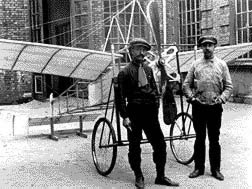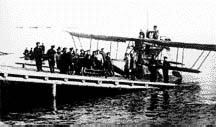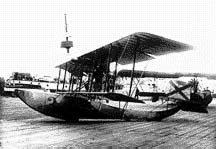|

Summer 1996 (4.2)
Pages 70-71
Biplanes and
Seaplanes
Beginnings
of Aviation in Azerbaijan
by Fuad Akhundov and
Nina Fischeva
Photos Courtesy of the Azerbaijan State Archives
  The history of
aviation in Azerbaijan goes back to 1910 when the Oil Boom was
in full swing in Baku and there was considerable business and
cultural interchange with Europe. The history of
aviation in Azerbaijan goes back to 1910 when the Oil Boom was
in full swing in Baku and there was considerable business and
cultural interchange with Europe.
Photo: Students of Baku Technical College
(now the Oil Academy) alongside the airplane they constructed
in 1910.
Aviation was a technical innovation
at the time. The Wright Brothers had just tested their first
powered plane in 1903 and signed contracts with Europe for the
production of their planes in 1908.
Everyone was eager to see these new flying machines and so an
International Aviation Week was organized which took place in
October 1910. At that time the population of Baku barely exceeded
200,000 inhabitants. However, the role of Baku as a rapidly growing
industrial center and the most advanced city of the entire region
was indisputable. Therefore, it was selected to host the first
aviation show in the Caucasus. Flights were scheduled to take
place in a field near Balakhany Highway (now the main road to
the airport). Two famous pilots, Sergey Utochkin and Gaver Vlynsky,
were invited to participate. Utochkin's flights were scheduled
for October 20-23, 1910.
Bakuites took an overwhelming interest in the show. So much so
that the price of tickets could demand an exorbitant 30 rubles
60 kopecks for an improvised box, seating six persons at the
edge of the airfield. Such a price was equivalent to an entire
month's salary for an oil worker.
The flights were supposed to begin at 1:00 pm that afternoon
but the crowd had been gathering since early morning. By 3:00
pm the field was totally overcrowded but more people just kept
coming. Mounted police and soldiers were required to control
such a large crowd.
Around 3:30 pm, the plane was rolled out of the hangar. It was
a "Farman" type biplane, the most up-to-date model.
Then Utochkin started the engine. At first, it produced a rather
wheezing sound but soon afterwards, it caught and the gigantic
propeller started to turn.
  Photo: View
of Gaber Vlynsky's Plane, the most advanced in its time with
a 50 horsepower engine. Vlynsky demonstrated it at the first
airshow in Baku Photo: View
of Gaber Vlynsky's Plane, the most advanced in its time with
a 50 horsepower engine. Vlynsky demonstrated it at the first
airshow in Baku
in October 1910.
The plane stood motionless for
a few moments while soldiers held on to its tail. Then the command
was given. The tail was released and the plane began to move.
It wasn't long before it shot up like a bird. However, a strong
gust of wind carried it off course far to the left. Nevertheless,
Utochkin managed to maintain control and after circling the airfield,
he brought it down successfully. The crowd went wild and kept
applauding until the demonstration was repeated four more times!
Almost Disaster
In the remaining days
that followed, Baku experienced strong winds, which were typical
of the season. However, Utochkin refused to cancel the flights,
though it was too dangerous to circle overhead. In several instances,
he took off and flew only a few meters landing on the other side
of the field.
  Left: Practical Classes at the Naval Aviation
Officer's School in Baku, 1916. Left: Practical Classes at the Naval Aviation
Officer's School in Baku, 1916.
On the very last day after managing
to climb quite high and gain sufficient altitude, all of a sudden
there was a loud clunking sound and the engine backfired, putting
the plane into a tailspin. The audience was horror-struck as
it witnessed the plane falling headlong above them. Just in the
niche of time, Utochkin managed to pull the plane out of the
spin just before it would have crashed. The crowd heaved a sigh
of relief as the plane landed safely near the hangar and Utochkin
jumped out. Bakuites greeted him as a hero and began chanting
his name and extending bouquets of flowers.
The International Aviation Week continued with Gaber Vlynsky,
another famous pilot of that time. Vlynsky was known as a fearless
aviator and had been awarded Aviation Club diplomas in Paris
(France), Odessa (Ukraine) and Rostov (Russia). He arrived in
Baku on October 28, 1910. Vlynsky's beplane was equipped with
the most advanced engine-the "Gnom" model which had
a capacity of 50-horse power. Three days of Gaber Vlynsky's flights
(October 28, 29 and 30) turned into another memorable event for
Baku.
First Naval Aviation
School
In the middle of World
War I, the Russian Government decided to set up a special Naval
Aviation Officers' School. They wanted a port for their seaplanes
and chose Baku as it would be least affected by the cruel winter
weather. The School was organized jointly by the General Naval
Headquarters and the Aircraft Department of Russia. Three hangars
and a short launching pier were constructed on the largest wharf
of the city, "Stony Wharf," in front of Mir Babayev's
Residence (nowadays the SOCAR Office Building).

 Photo: Seaplane type FBA, #67 at the wharf
of the Naval Aviation Officers' School, in front of the present-day
SOCAR Building (State Oil Company of Azerbaijan) in Baku 1916. Photo: Seaplane type FBA, #67 at the wharf
of the Naval Aviation Officers' School, in front of the present-day
SOCAR Building (State Oil Company of Azerbaijan) in Baku 1916.
The opening ceremonies for the
Naval School took place on November 1915 with more than 500 outstanding
Bakuites present, including city administrators, prominent Oil
Barons, public figures, religious clergy, scientists and the
mass media.
"Kaspiy", the largest Russian language pre-Revolutionary
newspaper in Baku, published a description of the first seaplane
flight which reads, "Sailing over the waves, the seaplane
took off smoothly like a magic flying fish, feeling itself both
King of the Sea and the Air. It was a magnificent sight."
The Administrative Board and Training Personnel of the Naval
Aviation School in Baku originally consisted of 30 officers.
The students were all volunteers. Within two years (1915-1917),
they managed to train a number of excellent pilots and specialists
in the field of naval aviation.
Unfortunately, the disturbances and disorder brought on by the
Russia Revolution in 1917, tragically interrupted the traditions
established of this first Naval Aviation Officer's School. The
institution was short-lived (1915-1917) and its history consigned
to oblivion during the Soviet Period.
Fuad Akhundov is a regular contributor about Baku's early
history. Nina Fischeva has worked with at Azerbaijan State Archives
for more than 35 years. She is Director of its Photo and Cinema
Materials.
From Azerbaijan International (4.2) Summer 1996
© Azerbaijan International 1996. All Rights Reserved.
Back to Index
AI 4.2 (Summer 1996)
AI Home
| Magazine
Choice
| Topics
| Store
| Contact
us
|




